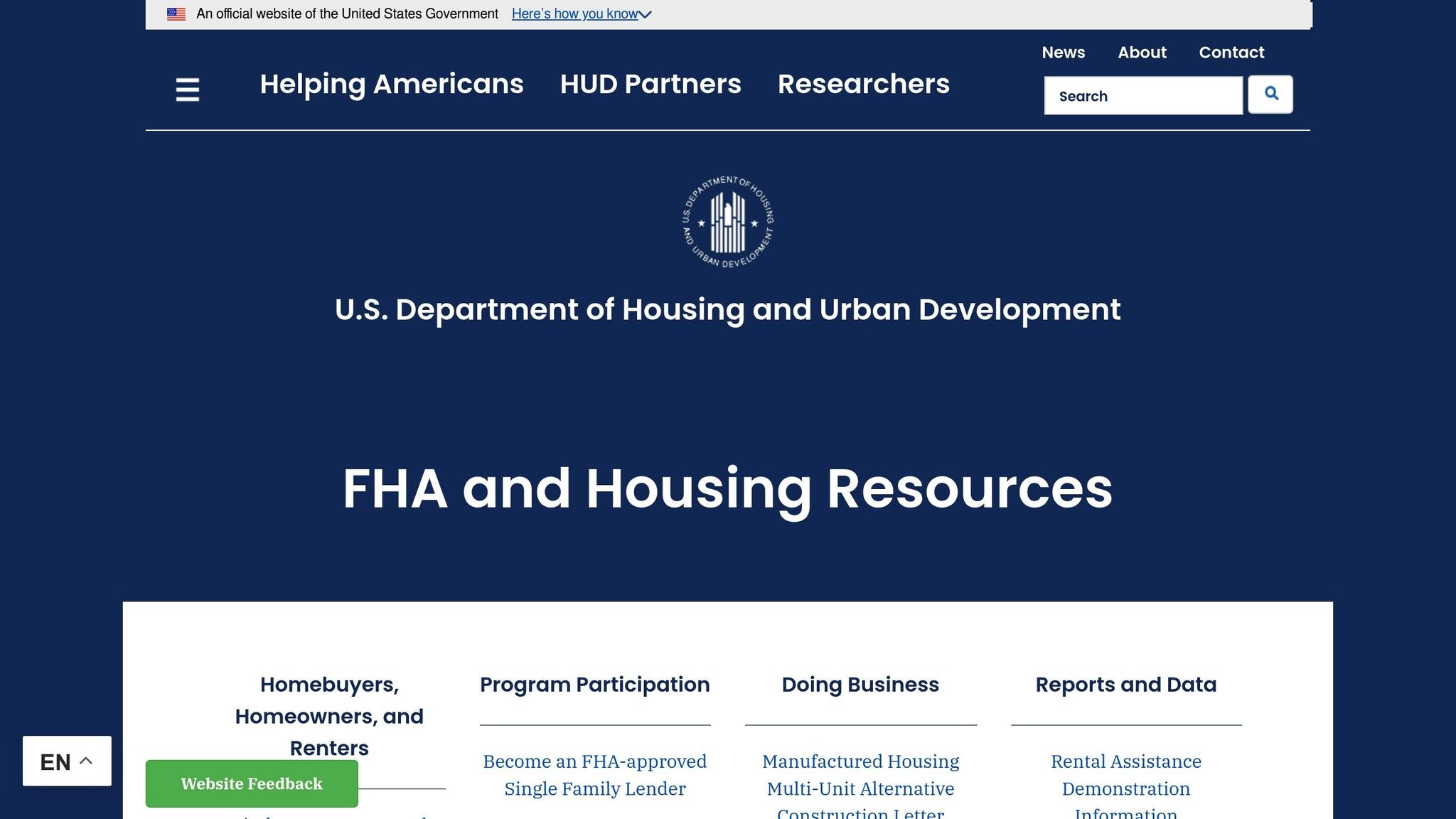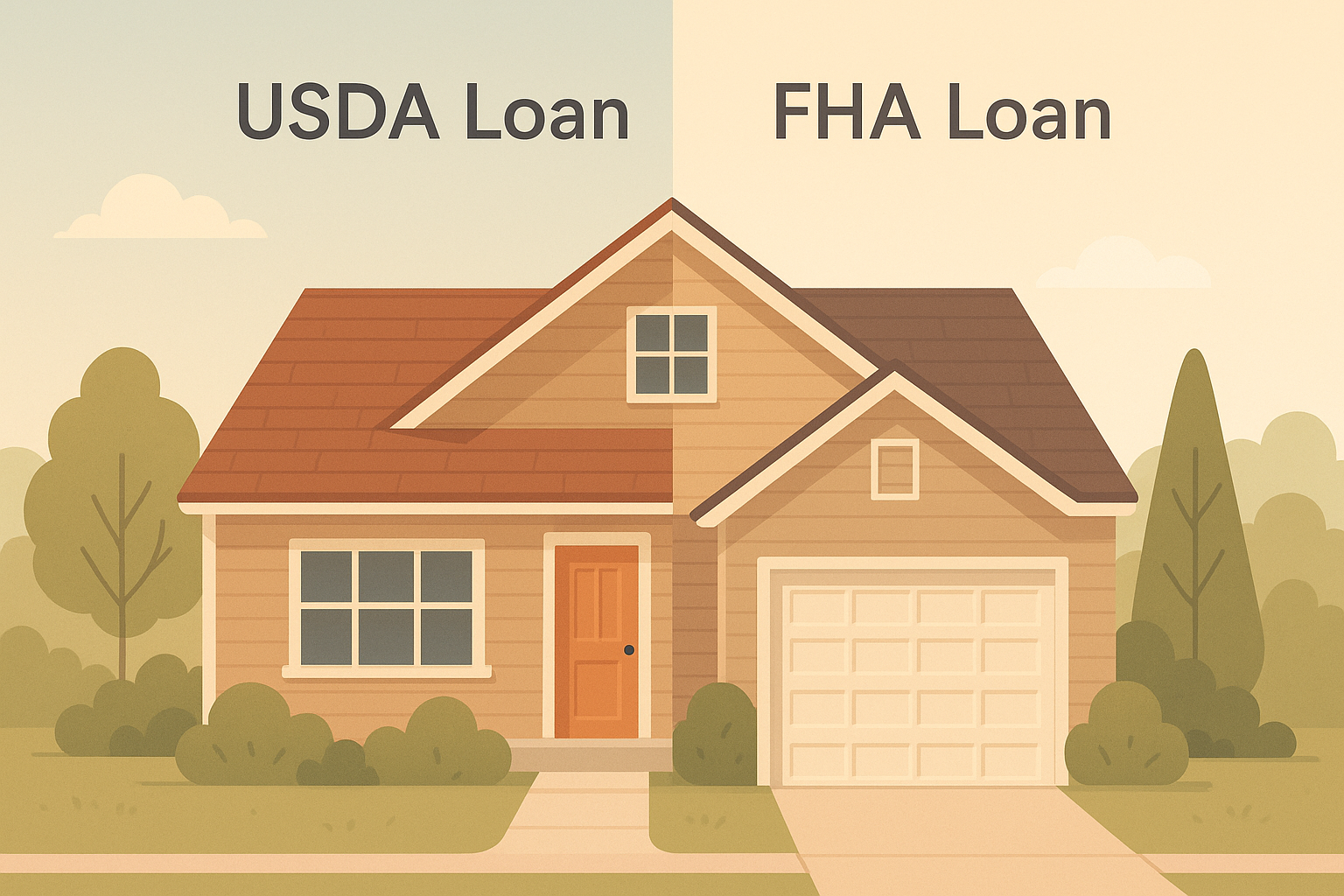When deciding between USDA and FHA loans, here’s what you need to know:
- USDA loans: Ideal for rural/suburban buyers with no down payment, lower interest rates, and income limits. Property must be in a USDA-eligible area.
- FHA loans: Great for first-time buyers with flexible credit requirements, a 3.5% down payment (for 580+ credit scores), and no location restrictions. Includes mandatory mortgage insurance.
Both loans are government-backed and offer benefits for specific needs. In Austin, USDA loans suit outer suburbs, while FHA loans work for properties across the metro area.
Quick Comparison:
| Feature | USDA Loans | FHA Loans |
|---|---|---|
| Down Payment | 0% | 3.5% (580+ credit), 10% (500-579 credit) |
| Credit Score | 640+ | 500+ |
| Property Location | Rural/suburban areas only | No restrictions |
| Income Limits | Yes, varies by area | None |
| Insurance Costs | Lower guarantee fees | Higher MIP costs |
| Loan Types | Fixed-rate only | Fixed and adjustable rates |
Choose USDA if you’re buying in rural areas and want lower costs. Opt for FHA for more flexibility in location and credit requirements.
FHA Loans vs USDA Loans (2021) – Which Is Better For You?

Basic Requirements and Qualifications
Understanding these essentials helps you compare interest rates and terms more effectively.
USDA Loan Basics
USDA loans provide a zero down payment option and are designed for properties in USDA-approved rural and suburban areas, including many neighborhoods within commuting distance of Austin.
Key features include:
- The property must be located in a USDA-eligible area and serve as the primary residence.
- Income limits apply and vary based on location and household size.
- Loans are fully backed by the USDA.
In the Austin area, USDA-eligible zones include parts of Bastrop, Hays, and Caldwell counties. Eligibility maps are updated regularly. FHA loans, on the other hand, offer more flexibility with a small down payment.
FHA Loan Basics
FHA loans are popular with first-time homebuyers due to their relaxed qualification criteria.
Core features include:
- A 3.5% down payment for credit scores of 580 or higher.
- A 10% down payment for credit scores between 500 and 579.
- Mandatory mortgage insurance premiums (MIP).
- No restrictions on property location.
Eligibility Requirements
Both USDA and FHA loans have specific requirements borrowers must meet.
| Requirement | USDA Loans | FHA Loans |
|---|---|---|
| Minimum Credit Score | 640 | 500 |
| Down Payment | 0% | 3.5% – 10% |
| Income Limits | Yes, varies by area | No income limits |
| Property Location | Rural/suburban only | Any location |
| Debt-to-Income Ratio | 41% | 43% |
| Mortgage Insurance | 1% upfront, 0.35% annual | 1.75% upfront, 0.55%-1.05% annual |
| Primary Residence | Required | Required |
In addition to these requirements, borrowers for both loan types must show:
- A stable employment history of at least two years.
- The ability to repay the loan.
- A clean credit history without recent bankruptcies or foreclosures.
- U.S. citizenship or eligible residency status.
USDA properties must also be in eligible areas and adhere to specific safety standards. FHA properties must pass an appraisal to confirm both value and safety.
Interest Rates and Loan Terms
USDA Rates and Terms
USDA loans come with fixed-rate mortgages available in 15- or 30-year terms. These loans, backed by the government, often have lower interest rates compared to conventional loans. They also feature no prepayment penalties, and their funding and ongoing fees are based on the remaining loan balance. However, the exact rates, fees, and terms can differ depending on the lender.
FHA Rates and Terms
FHA loans offer both fixed-rate and adjustable-rate options. Borrowers should account for mortgage insurance premiums, which add upfront and annual costs. These loans come with various fixed-term options and adjustable-rate schedules, depending on market conditions and lender-specific policies.
Rate Comparison
Here’s how USDA and FHA loans stack up in key areas:
| Feature | USDA Loans | FHA Loans |
|---|---|---|
| Typical Interest Rate | Generally lower due to government support | Competitive, but costs increase with mortgage insurance |
| APR Considerations | Often more favorable due to simpler fee structures | May be higher because APR includes insurance costs |
| Insurance and Fees | Lower, with fees tied to funding charges | Higher, with both upfront and annual insurance premiums |
| Rate Options | Only available as fixed-rate products | Offers both fixed-rate and adjustable-rate options |
| Rate Lock Period | Often longer lock periods | Lock periods vary and are sometimes shorter than USDA loans |
Several factors, including your credit score, debt-to-income ratio, property location, and current market trends, impact the rates and terms you’ll be offered. While USDA loans might have a slight edge in rates for some borrowers, their eligibility requirements and property location restrictions make them less accessible for everyone. Carefully weigh these distinctions when exploring your financing options, especially for Austin buyers, as discussed in the next section.
sbb-itb-4c99469
Pros and Cons
USDA Loan Advantages
USDA loans come with some clear perks. One standout is the 0% down payment requirement, making homeownership more accessible. These loans also offer competitive interest rates, which are often lower than conventional or FHA loans, leading to long-term savings.
Another benefit is the simpler fee structure, which is tied to the remaining loan balance. This setup keeps costs lower for borrowers over time. However, USDA loans do have some restrictions – they’re limited to USDA-designated rural areas and come with income limits that vary by region and household size.
FHA Loan Advantages
FHA loans, on the other hand, shine when it comes to flexibility. Borrowers with credit scores as low as 580 can qualify with a 3.5% down payment, while those with scores between 500-579 can still qualify if they put 10% down.
FHA loans also allow for a variety of property types, including multi-unit properties with up to four units, and they don’t have location restrictions. The main downside? Borrowers must pay mortgage insurance premiums (MIP), which include an upfront fee and ongoing annual costs.
Side-by-Side Comparison
| Feature | USDA Loans | FHA Loans |
|---|---|---|
| Down Payment | 0% | 3.5% (580+ credit), 10% (500-579 credit) |
| Property Location | Rural areas only | No restrictions |
| Credit Score | 640+ | As low as 500 |
| Insurance/Fees | Lower guarantee fees | Higher MIP costs |
| Income Limits | Yes, varies by region | None |
| Property Types | Single-family primary residence | 1-4 unit properties |
| Rate Structure | Fixed-rate | Fixed and adjustable rates |
| Debt-to-Income Ratio | Max 41% | Up to 43% |
This breakdown helps clarify which loan might work best for Austin homebuyers. For those with strong credit looking to buy in rural areas, USDA loans offer the advantage of no down payment and lower fees. Meanwhile, FHA loans are a better fit for buyers who need flexibility in property type or location – or for those with lower credit scores.
Loan Selection for Austin Buyers
Austin Market Factors
The Austin housing market presents specific challenges for USDA and FHA loans. USDA loans are restricted to properties in outer suburbs or rural areas, leaving most homes within Austin city limits ineligible. On the other hand, FHA loans are more accommodating, offering a 3.5% down payment option that appeals to first-time buyers grappling with rising home prices.
Here’s a quick comparison of how these loans are affected by key market factors:
| Factor | USDA Loan Impact | FHA Loan Impact |
|---|---|---|
| Location Eligibility | Restricted to outer suburbs and rural areas | Available across the entire Austin metro area |
| Property Types | Limited to single-family homes | Includes condos, townhomes, and 1-4 unit properties |
| Price Range | Subject to income limits | No income limits |
| Urban Development | Shrinking eligible areas as the city grows | Unaffected by urban expansion |
Navigating these nuances requires expert local advice.
Austin Local Team Services

Given these challenges, working with knowledgeable professionals is essential. Austin Local Team specializes in connecting buyers with agents who understand the ins and outs of USDA and FHA loan requirements in the area.
Here’s what the Austin Local Team offers:
- Market Analysis: Detailed property data to identify USDA-eligible zones and FHA-friendly areas.
- Agent Matchmaking: Pairing buyers with experienced real estate agents.
- Property Search Tools: Access to Central Texas MLS listings for informed decisions.
- Location Guidance: Advice on choosing neighborhoods that align with specific loan criteria.
Summary
When weighing USDA and FHA loans in the Austin area, your choice will depend on your specific needs and circumstances. USDA loans often feature lower interest rates and require no down payment, but they’re limited to properties in rural areas or the outer suburbs of Austin. On the other hand, FHA loans allow for greater property eligibility throughout the entire metro area, with competitive rates and a manageable 3.5% down payment.
Here’s a quick comparison of the key features:
| Feature | USDA Loans | FHA Loans |
|---|---|---|
| Property Location | Rural/outer suburbs | Entire Austin metro area |
| Property Types | Single-family homes | Single-family, condos, 1-4 units |
| Geographic Flexibility | Limited as Austin expands | Full metro area coverage |
"Austin Local Team was great! Extremely grateful for a real estate agent who was knowledgeable about issues moving from out of state. Good communication and setting expectations with deadlines." – Michael C.
To navigate the choice between USDA and FHA loans, having expert advice can make all the difference. Austin Local Team offers:
- Market Analysis: Detailed insights into USDA-eligible areas
- Agent Matchmaking: Connecting you with loan-specific expertise
- Location Guidance: Advice on neighborhoods that meet loan requirements
- Property Search Tools: Direct access to up-to-date MLS listings
Their resources and expertise can help you make the best decision for your home-buying journey.
FAQs
What are the key differences between USDA and FHA loans when it comes to credit score requirements and income limits?
USDA and FHA loans differ significantly in their eligibility criteria, particularly regarding credit scores and income limits.
USDA loans typically require a minimum credit score of 640, though some lenders may consider lower scores. Additionally, USDA loans are designed for low- to moderate-income borrowers, and applicants must meet specific income limits based on their location and household size. These loans are also limited to properties in designated rural or suburban areas.
FHA loans, on the other hand, are more flexible with credit requirements, often allowing scores as low as 580 for a 3.5% down payment, or even 500 with a higher down payment. Unlike USDA loans, FHA loans do not have income limits and are available nationwide, making them a more accessible option for a broader range of buyers.
How do USDA loan interest rates and mortgage insurance costs compare to FHA loans?
USDA loans generally offer lower interest rates compared to FHA loans, making them an attractive option for eligible buyers. Additionally, USDA loans typically have lower mortgage insurance costs, which can help reduce monthly payments over time. However, USDA loans are limited to properties in designated rural areas and are subject to specific income requirements.
FHA loans, on the other hand, are more widely available and have more flexible credit score requirements, but they usually come with higher mortgage insurance premiums that last for the life of the loan unless a significant down payment is made. Choosing between the two depends on your financial situation, eligibility, and the location of the property you’re interested in.
When might a homebuyer in the Austin area benefit more from a USDA loan instead of an FHA loan, considering location and property type requirements?
USDA loans can be a great option for buyers in the Austin area who are looking to purchase a home in eligible rural or suburban locations and meet specific income requirements. These loans often come with lower interest rates and no down payment, making them attractive for buyers who qualify. However, USDA loans are limited to certain geographic areas and property types, which may not include all parts of Austin or its surrounding neighborhoods.
On the other hand, FHA loans are more flexible in terms of location and property eligibility, making them a better choice for buyers looking in urban areas or for homes that don’t meet USDA criteria. FHA loans also have less strict income limits, which may suit buyers with higher earnings. To determine the best fit for your needs, consider your location, income, and property preferences.
